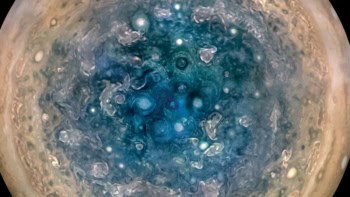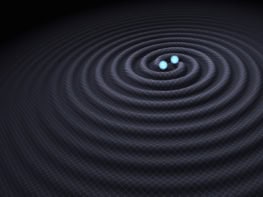
The best evidence yet of a planet beyond our solar system that is about the same size and temperature as the Earth has been released by a team of international astronomers. Preliminary measurements of the exoplanet’s temperature, mass and radius suggest that it made almost entirely of liquid water – although it could have a small rocky core.
The exoplanet is called GJ 1214b and was spotted by David Charbonneau and colleagues at Harvard University along with researchers in the US, Denmark, Switzerland and France.
GJ 1214b circles a nearby “M dwarf” star that is much smaller than our Sun. The exoplanet is about 2.5 times the diameter of Earth and about 6.5 times Earth’s mass.
It orbits its star once every 1.6 days at a distance of about 15 stellar radii. The Earth, by contrast, is about 215 solar radii from the Sun.
Liquid planet
Together, these parameters suggest that GJ 1214b has the same density of water – and Charbonneau told physicsworld.com that it is very likely that the exoplanet is made entirely of liquid water.
The team believes that the surface temperature of the exoplanet is somewhere between 120 and 280 °C. While this is well above the boiling point of water on Earth, Charbonneau says that the higher gravitational field – and hence pressure – would ensure liquid water.
Another possibility is that the planet has a small rocky core surrounded by a massive water ocean and finally an outer atmosphere of hydrogen and helium. However, this view cannot be verified because the team has not been able to study the composition of the planet in any detail.
That would require the use of a space telescope such as Hubble to look for tiny absorption and emission lines in starlight that passes through the exoplanet’s atmosphere on its way to Earth. Charbonneau and colleagues have applied for time on Hubble and hope to do such a study next year.
Off the shelf
Although expensive instruments like Hubble will be required to learn more about GJ 1214b, the planet was in fact discovered using an array of eight “off-the-shelf” 16-inch telescopes installed at the F L Whipple Observatory on Mt Hopkins, Arizona. Dubbed the MEarth Observatory, the telescopes are robotically controlled to systematically study known M dwarf stars, which are much smaller and dimmer than the Sun.
GJ 1214b was detected by MEarth because its star’s brightness varied when measured on successive days – because some of the starlight is blocked by the exoplanet. MEarth is led by Charbonneau, who described it as a “risky thing to do”. However, it appears to be worth it because GJ 1214b was discovered just three months into the planned three-year observational run.
Fantastic stuff
Frederic Pont, an astronomer at the University of Exeter in the UK, thinks that MEarth is “a fantastic project” and that the discovery of GJ 1214b is “more convincing” than that of CoRoT 7b, which is the smallest known exoplanet.
Although GJ 1214b is larger than CoRoT 7b, it is cool enough to have liquid water – an important precursor for life. In addition, the evidence for GJ 1214b is much more conclusive than CoRoT 7b, the existence of which was based on data analysis techniques that have been questioned by some astronomers.
The research is reported in Nature.



